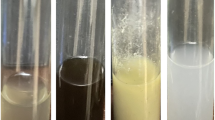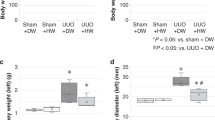Abstract
Renal tubular cell injury induced by oxalate plays an important role in kidney stone formation. Water containing oxygen nano-bubbles (nanometer-sized bubbles generated from oxygen micro-bubbles; ONB) has anti-inflammatory effects. Therefore, we investigated the inhibitory effects of ONB water on kidney stone formation in ethylene glycol (EG)-treated rats. We divided 60 rats, aged 4 weeks, into 5 groups: control, the water-fed group; 100 % ONB, the 100 % ONB water-fed group; EG, the EG treated water-fed group; EG + 50 % ONB and EG + 100 % ONB, water containing EG and 50 % or 100 % ONB, respectively. Renal calcium oxalate (CaOx) deposition, urinary excretion of N-acetyl-β-d-glucosaminidase (NAG), and renal expression of inflammation-related proteins, oxidative stress biomarkers, and the crystal-binding molecule hyaluronic acid were compared among the 5 groups. In the control and 100 % ONB groups, no renal CaOx deposits were detected. In the EG + 50 % ONB and EG + 100 % ONB groups, ONB water significantly decreased renal CaOx deposits, urinary NAG excretion, and renal monocyte chemoattractant protein-1, osteopontin, and hyaluronic acid expression and increased renal superoxide dismutase-1 expression compared with the EG group. ONB water substantially affected kidney stone formation in the rat kidney by reducing renal tubular cell injury. ONB water is a potential prophylactic agent for kidney stones.










Similar content being viewed by others
References
Curhan GC (2007) Epidemiology of stone disease. Urol Clin North Am 34:287–293
Tracy CR, Pearle MS (2009) Update on the medical management of stone disease. Curr Opin Urol 19:200–204
Hirose M, Tozawa K, Okada A et al (2008) Gyloxylate induces renal tubular cell injury and microstructural change in experimental mouse. Urol Res 36:139–147
Huang HS, Chen J, Chen CF, Ma MC (2006) Vitamin E attenuates crystal formation in rat kidneys: roles of renal tubular cell death and crystallization inhibitors. Kidney Int 70(4):699–710
Itoh Y, Yasui T, Okada A et al (2005) Preventive effects of green tea on renal stone formation and the role of oxidative stress in nephrolithiasis. J Urol 173:271–275
Yasui T, Itoh Y, Kohri K (2007) Aortic calcification in urolithiasis patients. Scand J Urol Nephrol 41:419–421
De Water R, Noordermeer C (2000) Role of macrophage in nephrolithiasis in rats: an analysis of renal interstitium. Am J Kidney Dis 36:615
Denhardt DT, Noda M, O’Regan AW et al (2001) Osteopontin as a means to cope with environmental insults: regulation of inflammation, tissue remodeling, and cell survival. J Clin Invest 107:1055–1061
Takahashi M (2005) Zeta potential of microbubbles in aqueous solutions: electrical properties of the gas–water interface. J Phys Chem B 190:21858–21864
Hayakumo S, Arakawa S, Mano Y, et al (2012) Clinical and microbiological effects of ozone nano-bubble water irrigation as an adjunct to mechanical subgingival debridement in periodontitis patients in a randomized controlled trial. Clin Oral Invest. (Epub ahead of print)
Hojo Y, Takahashi M (2006) Anti-inflammatory property of oxygen nano-bubbles. Circ J 70(Supplement 1):276
Hojo Y (2009) Anti-inflammatory and anti-proliferative action of oxygen nanobubbles. Mater Integr 22:44–48 (in Japanese)
Chiba K, Takahashi M (2007) Oxygen nanobubble water and method of producing the same. US patent, 2007/0286795 A1. Dec.13
Takahashi M, Chiba K, Li Pan (2007) Free-radical generation from collapsing microbubbles in the absence of a dynamic stimulus. J Phys Chem B 111:1343–1347
Agarwal A, Ng WJ, Liu Y (2011) Principle and applications of microbubble and nanobubble technology for water treatment. Chemosphere 84:1175–1180
Mano Y, Chiba K. Functional water production method. JP, 2011-72965, A. 2011-04-14
Pizzolato P (1971) Mercurous nitrate as a histochemical reagent for calcium phosphate in bone and pathological calcification and for calcium oxalate. Histochem J 3:463–469
Okada A, Nomura S, Saeki Y et al (2008) Morphological conversion of calcium oxalate crystals into stones is regulated by osteopontin in mouse kidney. J Bone Miner Res 23:1629–1637
Honda K, Yoshimura M, Rao TN et al (2003) Electrogenerated chemiluminescence of the ruthenium tris(2,2′)bipyridyl/amines system on a boron-doped diamond electrode. J Phys Chem B 107:1653–1663
Tiselius HG, Ferraz RR, Heilberg IP (2003) An approximate estimate of the ion-activity product of calcium oxalate in rat urine. Urol Res 31:410–413
Coe FL, Evan A, Worcester E (2005) Kidney stone disease. J Clin Invest 115:2598–2608
Verkoelen CF (2006) Crystal retention in renal stone disease: a crucial role for the glycosaminoglycan hyaluronan? J Am Soc Nephrol 17:1673–1687
Matlaga BR, Coe FL, Evan AP et al (2007) The role of Randall’s plaques in the pathogenesis of calcium stones. J Urol 177:31–38
Nankivell BJ, Borrows RJ, Fung CL et al (2003) The natural history of chronic allograft nephropathy. N Engl J Med 349:2326–2333
Gobel U, Kettritz R, Schneider W et al (2001) The protean face of renal sarcoidosis. J Am Soc Nephrol 12:616–623
Milliner DS, Wilson DM et al (2001) Phenotypic expression of primary hyperoxaluria: comparative features of types I and II. Kidney Int 59:31–36
Boettger T, Hubner CA, Maier H et al (2002) Deafness and renal tubular acidosis in mice lacking the K-Cl co-transporter Kcc4. Nature 416:874–878
Moutsopoulos HM, Cledes J, Skopouli FN et al (1991) Nephrocalcinosis in Sjögren’s syndrome: a late sequela of renal tubular acidosis. J Intern Med 230:187–191
Umekawa T, Byer K, Khan SR (2005) Diphenyleneiodium (DPI) reduces oxalate ion- and calcium oxalate monohydrate and brushite crystal-induced upregulation of MCP-1 in NRK 52E cells. Nephrol Dial Transplant 20:870–878
Kohri K, Nomura S, Kitamura Y et al (1993) Structure and expression of the mRNA encoding urinary stone protein (osteopontin). J Biol Chem 268:15180–15184
Kohri K, Suzuki Y, Yoshida K et al (1992) Molecular cloning and sequencing of cDNA encoding urinary stone protein, which is identical to osteopontin. Biochem Biophys Res Commun 30(184):859–864
Yamate T, Kohri K, Umekawa T et al (1999) Interaction between osteopontin on madin darby canine kidney cell membrane and calcium oxalate crystal. Urol Int 62:81–86
Kumar V, Peña de la Vega L, Farell G et al (2005) Urinary macromolecular inhibition of crystal adhesion to renal epithelial cells is impaired in male stone formers. Kidney Int 68:1784–1792
Hamamoto S, Nomura S, Yasui T et al (2010) Effects of impaired functional domains of osteopontin on renal crystal formation: analyses of OPN transgenic and OPN knockout mice. J Bone Miner Res 25:2712–2723
Asselman M, Verhulst A, Ballegooijen ESV (2005) Hyaluronan is apically secreted and expressed by proliferating or regenerating renal tubular cells. Kidney Int 68:71–83
Tammi MI, Day AJ, Turley EA (2002) Hyaluronan and homeostasis: a balancing act. J Biol Chem 15(277):4581–4584
Huang HS, Ma MC, Chen J et al (2002) Changes in the oxidant-antioxidant balance in the kidney of rats with nephrolithiasis induced by ethylene glycol. J Urol 167:2584–2593
Zelko IN, Mariani TJ, Folz RJ (2002) Superoxide dismutase multigene family: a comparison of the CuZn-SOD(SOD1), Mn-SOD(SOD2), and EC-SOD(SOD3) gene structures, evolution, and expression. Free Radic Biol Med 33:337–349
Sakata K, Yamasaki K (2007) Waste water treatment by micro- and nano-bubble technology in the cleaning process of semiconductor manufacturing. J JSMF 21:203–204
Onari H (2001) Fisheries experiments of cultivated shells using micro-bubbles techniques. J Heat Transf Soc Japan 40:2–7 (in Japanese)
Tsutsumi H (2010) Application of micorobubble injector to marine fish farming and its future perspective. Bull Soc Sea Water Sci Jpn 64:31–38 (in Japanese)
Park JS (2010) Promotion of lettuce growth by application of microbubbles in nutrient solution using different rates of electrical conductivity and under periodic intermittent generation in a deep flow technique culture system. Eur J Hortic Sci 75:198–203
Park J, Kurata K (2009) Application of microbubbles to hydroponics solution promotes lettuce growth. Hortic Technol 19:212–215
Ushikubo FY, Furukawa T, Nakagawa R, Enari M, Shiina T, Oshita S et al (2010) Evidence of the existence and the stability of nano-bubbles in water. Colloids Surf A 361:31–37
Acknowledgments
We thank Yoshihiro Mano of the Hyperbaric Medical Center, Hospital of Medicine, Tokyo Medical and Dental University for providing ONB water and valuable comments and Masayoshi Takahashi of the National Institute of Advanced Industrial Science and Technology for providing valuable comments. This study was supported by grants-in-aid from the Ministry of Education, Culture, Sports, Science, and Technology, Japan (MEXT/JSPSKAKENHI Grant Number 22791483 and 24659716 and 23592374).
Conflict of interest
All the authors declared no competing interests.
Author information
Authors and Affiliations
Corresponding author
Rights and permissions
About this article
Cite this article
Hirose, Y., Yasui, T., Taguchi, K. et al. Oxygen nano-bubble water reduces calcium oxalate deposits and tubular cell injury in ethylene glycol-treated rat kidney. Urolithiasis 41, 279–294 (2013). https://doi.org/10.1007/s00240-013-0576-5
Received:
Accepted:
Published:
Issue Date:
DOI: https://doi.org/10.1007/s00240-013-0576-5




